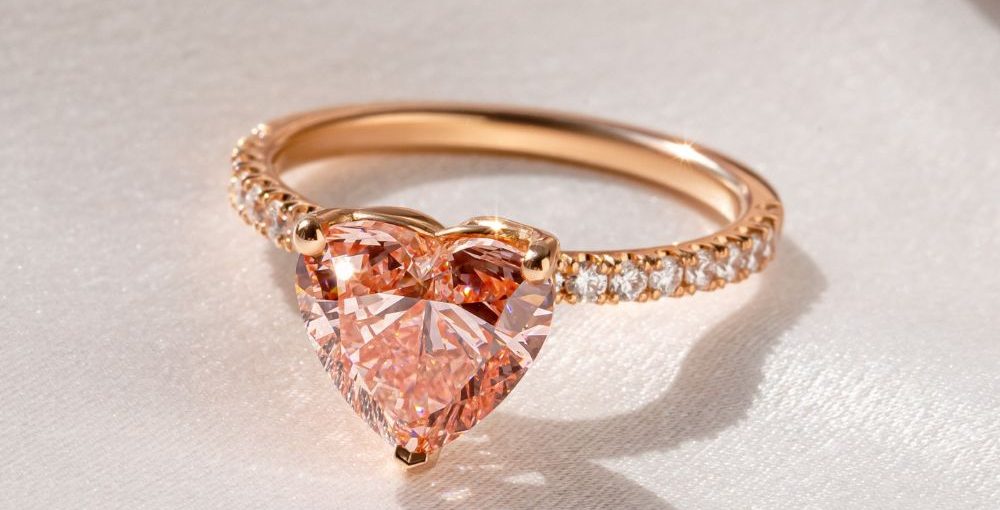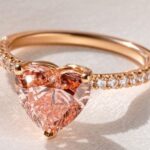The Complete Guide to Heart-Shaped Diamond Rings: Everything You Need to Know
Heart-shaped diamond rings are more than just beautiful jewelry. They tell a story of love, romance, and lifelong commitment. When you’re shopping for the perfect heart-shaped diamond ring, you’re not just buying a piece of jewelry—you’re choosing a symbol that will represent your feelings for years to come.
Whether you’re planning a proposal, celebrating an anniversary, or treating someone special to a unique gift, heart-shaped diamonds offer something truly special. These diamonds combine stunning beauty with deep meaning, making them perfect for life’s most important moments.
In this complete guide, we’ll walk you through everything you need to know about heart-shaped diamond rings. From understanding what makes these diamonds special to choosing the perfect 4-carat heart-shaped diamond ring, we’ve got you covered.
What Makes Heart-Shaped Diamonds So Special?
Heart-shaped diamonds are among the most romantic and meaningful diamond cuts available today. Unlike traditional round or square diamonds, heart-shaped stones carry a powerful message of love right in their design.
The History Behind Heart-Shaped Diamonds
Heart-shaped diamonds have been symbols of love for centuries. The cut combines technical skill with artistic beauty, creating a diamond that’s both challenging to create and stunning to behold. Master diamond cutters need exceptional skill to craft these stones properly.
Why People Choose Heart-Shaped Diamonds
People choose heart-shaped diamonds for many reasons:
- Romantic symbolism: The heart shape naturally represents love and devotion
- Unique appearance: These diamonds stand out from traditional cuts
- Personal meaning: They create a special connection between the giver and receiver
- Conversation starter: Their distinctive shape always draws attention and compliments
Understanding the Heart-Shaped Diamond Cut
The heart-shaped diamond is one of the most complex cuts in the jewelry world. Creating a perfect heart shape requires incredible precision and skill from the diamond cutter.
Key Features of Heart-Shaped Diamonds
A well-cut heart-shaped diamond has several important features:
Symmetrical lobes: The two rounded sections at the top of the heart must be perfectly matched. If one lobe is larger than the other, the diamond will look unbalanced.
Sharp point: The bottom of the heart should come to a clean, sharp point. A rounded or blunt point can make the diamond look less defined.
Clear cleft: The split between the two lobes should be distinct and well-defined. This cleft is what gives the diamond its heart shape.
Proper proportions: The length-to-width ratio should fall between 0.90 and 1.10 for the most attractive appearance.
Why Cut Quality Matters So Much
With heart-shaped diamonds, cut quality is absolutely critical. Even small imperfections in the cut can make the diamond look lopsided or poorly shaped. A diamond with poor cut quality might:
- Look smaller than its actual carat weight
- Appear dull or lifeless
- Have uneven light reflection
- Show visible flaws more easily
This is especially important when considering larger stones like a 4-carat heart-shaped diamond ring. The bigger the diamond, the more noticeable any flaws in the cut will become.
The Magic of 4-Carat Heart-Shaped Diamond Rings
A 4-carat heart-shaped diamond ring is truly a showstopper. These rings combine impressive size with romantic symbolism, creating a piece that’s both meaningful and magnificent.
Why 4 Carats Is Special
Four-carat diamonds are considered large and luxurious. When shaped into a heart, these diamonds become even more impressive:
- Significant presence: A 4-carat diamond is large enough to make a real statement
- Better light performance: Larger diamonds can show more brilliance and fire
- Enhanced symbolism: The bigger heart shape makes the romantic message even stronger
- Investment value: High-quality large diamonds often hold their value well
Things to Consider with Larger Heart-Shaped Diamonds
While 4-carat heart-shaped diamonds are beautiful, they do require special consideration:
Clarity becomes more important: Larger diamonds show inclusions (flaws) more easily than smaller stones. You’ll want to choose a diamond with good clarity.
Color is more noticeable: The color grade becomes more important in larger diamonds because any yellow or brown tint will be more visible.
Setting protection: The pointed tip of a heart-shaped diamond is vulnerable to chipping. Larger diamonds need protective settings.
How to Choose the Perfect Heart-Shaped Diamond
Selecting the right heart-shaped diamond involves understanding the “4 Cs” and how they apply specifically to this unique cut.
Cut Quality: The Most Important Factor
For heart-shaped diamonds, cut quality trumps everything else. Here’s what to look for:
Symmetry: Both lobes of the heart should be identical in size and shape. Hold the diamond up and imagine drawing a line down the center—both sides should mirror each other perfectly.
Length-to-width ratio: Most people prefer ratios between 0.90 and 1.10. A ratio closer to 1.00 creates a more traditional heart shape, while ratios toward 0.90 create a wider heart.
Depth and table percentages: These technical measurements affect how light moves through the diamond. Your jeweler can help you understand these numbers.
Polish and finish: The diamond’s surface should be smooth and well-finished to maximize sparkle.
Carat Weight Considerations
Heart-shaped diamonds can appear smaller than other cuts of the same carat weight because of their shape. The pointed bottom and curved top distribute the weight differently than round or square cuts.
When choosing carat weight, consider:
- Your budget: Larger diamonds cost significantly more per carat
- The wearer’s lifestyle: Very large diamonds might not be practical for everyday wear
- Personal preference: Some people prefer more subtle sizes, while others love bold statements
- Ring finger size: The diamond should look proportional to the wearer’s hand
Color Grade Selection
Diamond color grades range from D (completely colorless) to Z (light yellow or brown). For heart-shaped diamonds:
With white metals (platinum, white gold): Choose color grades G or higher for the best appearance. The white metal will make any yellow tint more noticeable.
With warm metals (yellow gold, rose gold): You can go with slightly lower color grades (H or I) because the warm metal will complement any slight color in the diamond.
For larger diamonds: Higher color grades become more important as size increases because color becomes more visible.
Clarity Considerations
Diamond clarity refers to the presence of inclusions (internal flaws) and blemishes (surface flaws). For heart-shaped diamonds:
Recommended clarity grades: VS1 or VS2 clarity usually provides the best value. These grades mean the diamond will look clean to the naked eye while not being overpriced.
Size matters: Larger diamonds like 4-carat stones show inclusions more easily, so you might want to consider higher clarity grades.
Inclusion location: Some inclusions are less noticeable depending on where they’re located in the diamond.
Choosing the Perfect Setting for Your Heart-Shaped Diamond
The setting you choose will protect your diamond and enhance its beauty. Different settings offer different benefits and styles.
Popular Setting Styles
Solitaire Settings Solitaire settings showcase the diamond with minimal distraction. These classic settings:
- Put all focus on the diamond itself
- Work well with any size diamond
- Offer timeless elegance
- Are usually the most affordable option
Halo Settings Halo settings surround the center diamond with smaller diamonds:
- Make the center stone appear larger
- Add extra sparkle and brilliance
- Protect the pointed tip of heart-shaped diamonds
- Create a more dramatic look
Bezel Settings Bezel settings wrap a metal band around the diamond’s edge:
- Provide excellent protection for the diamond
- Offer a modern, sleek appearance
- Work well for active lifestyles
- Help protect the vulnerable point of heart-shaped diamonds
Three-Stone Settings Three-stone settings feature the heart-shaped diamond with smaller stones on each side:
- Symbolize past, present, and future
- Add extra brilliance to the ring
- Create a more elaborate design
- Allow for creative color combinations
Special Considerations for Heart-Shaped Diamonds
Heart-shaped diamonds have unique setting needs:
Tip protection: The pointed end of the heart is the most vulnerable part. Look for settings that offer some protection to this area.
Prong placement: The prongs (metal claws that hold the diamond) should be positioned to enhance the heart shape, not hide it.
Size accommodation: Make sure the setting is designed specifically for heart-shaped diamonds to ensure proper fit and security.
Selecting the Right Metal for Your Ring
The metal you choose affects both the appearance and durability of your ring. Each option has its own benefits and considerations.
Popular Metal Options
Platinum Platinum is the premium choice for engagement rings:
- Extremely durable and long-lasting
- Naturally white color won’t fade
- Hypoallergenic (won’t cause skin reactions)
- Holds its value well
- More expensive than gold options
White Gold White gold offers a platinum-like appearance at a lower cost:
- Beautiful white color complements diamonds
- More affordable than platinum
- Durable enough for everyday wear
- May need occasional re-plating to maintain color
- Available in different karat weights (14k, 18k)
Yellow Gold Yellow gold provides a classic, warm appearance:
- Timeless and traditional look
- Complements lower color grade diamonds
- Available in different karat weights
- May require more maintenance than white metals
- Generally less expensive than platinum
Rose Gold Rose gold has become increasingly popular:
- Romantic pink color matches heart-shaped diamonds perfectly
- Trendy and fashionable
- Complements most skin tones
- Unique alternative to traditional metals
- May darken slightly over time
Choosing the Right Metal for Your Diamond
Consider these factors when selecting your metal:
Diamond color: White metals show off colorless diamonds best, while warm metals can complement diamonds with slight color.
Personal style: Think about what metals the wearer usually prefers in their jewelry.
Lifestyle: Some metals require more maintenance than others.
Budget: Platinum is typically the most expensive, followed by 18k gold, then 14k gold.
Understanding Diamond Certification
When buying a heart-shaped diamond, especially a valuable 4-carat stone, certification is crucial. Diamond certificates provide independent verification of the diamond’s quality and characteristics.
Important Certification Organizations
GIA (Gemological Institute of America)
- Most respected diamond grading organization worldwide
- Provides detailed reports on cut, color, clarity, and carat weight
- Uses strict, consistent grading standards
- Certificates are widely recognized and trusted
AGS (American Gem Society)
- Known for strict cut quality grading
- Uses both letter and number grading systems
- Particularly thorough in evaluating cut quality
- Well-respected in the industry
What Certificates Tell You
A diamond certificate provides crucial information:
- Exact carat weight down to the hundredth
- Color grade on the standard scale
- Clarity grade with detailed inclusion mapping
- Cut quality assessment
- Measurements and proportions
- Fluorescence level if present
- Unique identifying characteristics
Why Certification Matters
Certification is especially important for heart-shaped diamonds because:
- The cut quality is so critical to the diamond’s appearance
- It provides proof of the diamond’s characteristics
- It helps ensure you’re getting what you pay for
- It’s necessary for insurance purposes
- It helps with resale value if needed
Shopping Tips for Heart-Shaped Diamond Rings
Finding the perfect heart-shaped diamond ring requires knowledge, patience, and careful shopping. Here are expert tips to help you make the best choice.
Where to Shop
Reputable Jewelry Stores
- Established jewelers with good reputations
- Allow you to see diamonds in person
- Provide expert guidance and advice
- Usually offer warranties and return policies
- May have limited selection of heart-shaped diamonds
Online Diamond Retailers
- Larger selection of heart-shaped diamonds
- Often better prices due to lower overhead
- Detailed photos and videos available
- Easy comparison shopping
- May offer return policies and guarantees
Questions to Ask
When shopping for heart-shaped diamonds, ask these important questions:
- Can I see the diamond’s certificate? Always request to see the grading report.
- What is the return policy? Make sure you can return the ring if it’s not what you expected.
- Is the diamond certified? Only buy certified diamonds from reputable grading organizations.
- Can I see the diamond in different lighting? View the diamond in various light conditions.
- What warranty is included? Understand what’s covered and for how long.
- Are there any treatments? Ask if the diamond has been enhanced or treated in any way.
Red Flags to Avoid
Be cautious of these warning signs:
- Prices that seem too good to be true often indicate lower quality or misrepresented diamonds
- Pressure to buy immediately without time to consider your options
- Reluctance to show certificates or provide detailed information
- No return policy or very restrictive return terms
- Poor online reviews or lack of established reputation
Caring for Your Heart-Shaped Diamond Ring
Once you’ve chosen the perfect heart-shaped diamond ring, proper care will keep it looking beautiful for generations.
Daily Care Tips
Remove during activities: Take off your ring during:
- Household cleaning
- Exercise or sports
- Gardening or outdoor work
- Swimming in pools or hot tubs
Store safely: When not wearing your ring:
- Keep it in a soft pouch or lined jewelry box
- Store separately from other jewelry to prevent scratching
- Consider a safe or safety deposit box for very valuable rings
Handle carefully: Remember that the pointed tip of heart-shaped diamonds is vulnerable to chipping.
Regular Cleaning
At-home cleaning:
- Use warm soapy water and a soft toothbrush
- Soak the ring for 20-30 minutes
- Gently scrub around the diamond and setting
- Rinse thoroughly and dry with a soft cloth
Professional cleaning:
- Have your ring professionally cleaned every 6 months
- Many jewelers offer free cleaning services
- Professional cleaning can restore maximum sparkle
Professional Maintenance
Regular inspections: Have a jeweler check your ring annually to:
- Ensure prongs are secure
- Check for any damage to the diamond or setting
- Tighten any loose elements
- Polish the metal if needed
Insurance: Consider insuring valuable diamond rings through:
- Your homeowner’s or renter’s insurance policy
- Specialized jewelry insurance companies
- The jeweler’s insurance program
Heart-Shaped Diamond Ring Styles and Trends
Heart-shaped diamond rings come in many beautiful styles to suit different tastes and preferences.
Classic Styles
Traditional Solitaire The timeless solitaire setting remains the most popular choice:
- Clean, elegant lines
- All attention on the diamond
- Works with any size heart-shaped diamond
- Never goes out of style
Vintage-Inspired Designs Vintage-style settings add romantic details:
- Intricate metalwork and engravings
- Milgrain (beaded) edges
- Art Deco or Victorian influences
- Antique-style prong settings
Modern Trends
Halo Settings Halo settings continue to be extremely popular:
- Make the center diamond appear larger
- Add extra sparkle and brilliance
- Available in various halo shapes
- Can incorporate colored gemstones
Mixed Metal Designs Combining different metals creates unique looks:
- Rose gold with white gold accents
- Yellow gold with platinum details
- Creates visual interest and contrast
- Allows for personalization
Custom Design Options
Many couples choose custom-designed rings:
- Incorporate personal elements like birthstones or engravings
- Create unique settings that reflect personal style
- Choose specific proportions and details
- Work with designers to create one-of-a-kind pieces
The Investment Value of Heart-Shaped Diamond Rings
Understanding the investment aspect of diamond rings can help you make informed decisions about your purchase.
Factors Affecting Value
Diamond Quality The 4 Cs directly impact both immediate and long-term value:
- Higher grades typically retain value better
- Certified diamonds from reputable organizations hold value more consistently
- Rare combinations of high grades can appreciate over time
Market Demand Heart-shaped diamonds have specific market characteristics:
- Less common than round diamonds, which can affect resale
- Strong emotional appeal maintains consistent demand
- Large, high-quality heart-shaped diamonds are particularly rare
Ring Construction The overall quality of the ring affects its value:
- High-quality settings and craftsmanship last longer
- Reputable designers and jewelers add value
- Classic styles tend to hold value better than trendy designs
Protecting Your Investment
Proper Documentation Keep all important paperwork:
- Original certificates and appraisals
- Purchase receipts and warranties
- Insurance documentation
- Professional cleaning and maintenance records
Regular Appraisals Have your ring appraised every few years:
- For insurance purposes
- To track value changes
- To ensure adequate coverage
- To identify any needed repairs
Frequently Asked Questions
Are heart-shaped diamonds more expensive than other cuts?
Heart-shaped diamonds are typically priced similarly to other fancy cut diamonds like oval, pear, or marquise shapes. They’re usually less expensive than round diamonds of the same quality because round diamonds are in higher demand. However, well-cut heart-shaped diamonds with good symmetry can command premium prices due to the skill required to cut them properly.
How can I tell if a heart-shaped diamond has good symmetry?
Good symmetry in a heart-shaped diamond means both lobes are identical in size and shape, the cleft between them is well-defined, and the point is sharp and centered. The best way to check is to look at the diamond from directly above and imagine drawing a line down the center – both sides should mirror each other perfectly. Always ask to see the diamond’s certificate, which will include symmetry grades.
Do heart-shaped diamonds sparkle as much as round diamonds?
Heart-shaped diamonds can be incredibly brilliant when cut properly, but they may not sparkle quite as much as round diamonds. Round diamonds are specifically designed to maximize light return, while heart-shaped diamonds prioritize their romantic shape. However, a well-cut heart-shaped diamond will still display beautiful fire and brilliance that’s very impressive.
What’s the best length-to-width ratio for heart-shaped diamonds?
Most people prefer heart-shaped diamonds with length-to-width ratios between 0.90 and 1.10. A ratio of 1.00 creates a perfectly balanced heart shape, while ratios closer to 0.90 create wider hearts and ratios closer to 1.10 create more elongated hearts. The choice depends on personal preference, but staying within this range ensures an attractive appearance.
Are 4-carat heart-shaped diamonds too big for everyday wear?
Whether a 4-carat heart-shaped diamond is too big for everyday wear depends on personal preference, lifestyle, and hand size. While these are definitely statement pieces, many people wear large diamonds daily without problems. Consider the wearer’s lifestyle – someone with an active job might prefer a smaller stone, while someone who enjoys bold jewelry might love a 4-carat diamond.
How should I clean my heart-shaped diamond ring?
Clean your heart-shaped diamond ring regularly with warm soapy water and a soft toothbrush. Soak the ring for 20-30 minutes, then gently brush around the diamond and setting. Be extra careful around the pointed tip. Rinse thoroughly and dry with a soft cloth. Have the ring professionally cleaned every 6 months for best results.
What setting protects the point of a heart-shaped diamond best?
Bezel settings provide the most protection for heart-shaped diamonds because they wrap metal around the diamond’s edge. Halo settings also offer good protection by surrounding the diamond with smaller stones. If you prefer a more traditional look, make sure any prong setting has a prong specifically positioned to protect the pointed tip.
Can I resize a heart-shaped diamond ring?
Most heart-shaped diamond rings can be resized, but the process may be more complex than with simple solitaire settings. The exact method depends on the setting style and how much resizing is needed. It’s best to work with an experienced jeweler who has experience with heart-shaped diamonds to ensure the stone remains secure.
How do I insure a heart-shaped diamond ring?
To insure your heart-shaped diamond ring, you’ll need a current appraisal from a certified appraiser. You can add it to your homeowner’s or renter’s insurance policy, or purchase separate jewelry insurance. Make sure the policy covers the full replacement value and includes coverage for loss, theft, and damage. Keep all documentation including certificates, receipts, and photos.
What makes a 4-carat heart-shaped diamond special?
A 4-carat heart-shaped diamond is special because of its impressive size combined with romantic symbolism. At this size, the heart shape becomes very prominent and dramatic. Large heart-shaped diamonds are also relatively rare, making them unique and valuable. The combination of size, beauty, and meaning makes these rings true showstoppers that represent significant commitments and celebrations.




